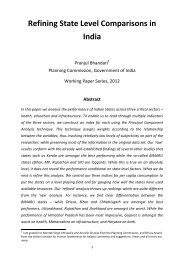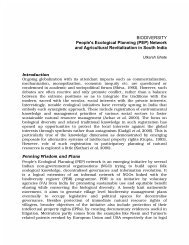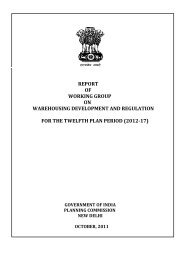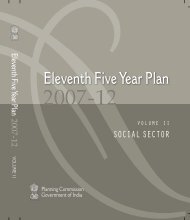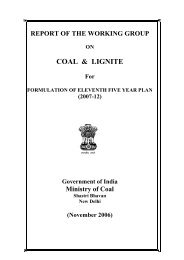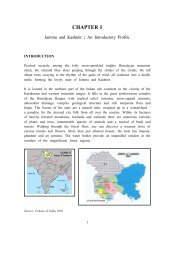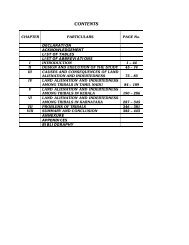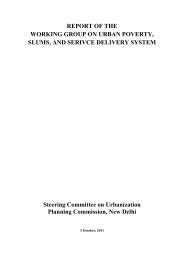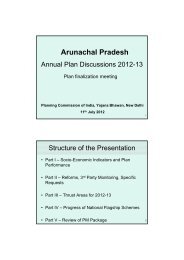Approach Paper for the Twelfth Five Year Plan - of Planning ...
Approach Paper for the Twelfth Five Year Plan - of Planning ...
Approach Paper for the Twelfth Five Year Plan - of Planning ...
You also want an ePaper? Increase the reach of your titles
YUMPU automatically turns print PDFs into web optimized ePapers that Google loves.
26 <strong>Approach</strong> to <strong>the</strong> <strong>Twelfth</strong> <strong>Five</strong> <strong>Year</strong> <strong>Plan</strong><br />
Figure 2.1:<br />
Trends in Tax Revenues at <strong>the</strong> Centre<br />
(1990 to 2017, including projections)<br />
Projections <strong>for</strong><br />
<strong>Twelfth</strong> <strong>Plan</strong><br />
2.35 Gross Tax Revenues <strong>of</strong> <strong>the</strong> Centre were 10.6 per cent <strong>of</strong> GDP in 1990-91, but declined <strong>for</strong> several<br />
years as custom duties and income tax rates were lowered. However, <strong>the</strong>y rose again after 2001-02,<br />
reaching a peak <strong>of</strong> 11.9 per cent in 2007-08. The tax ratio declined <strong>the</strong>reafter, because <strong>of</strong> <strong>the</strong> tax reduction<br />
introduced as part <strong>of</strong> <strong>the</strong> stimulus reaching 9.5 per cent <strong>of</strong> GDP in 2009-10. However, <strong>the</strong> trend has<br />
reversed again, and <strong>the</strong> gross tax-GDP ratio at <strong>the</strong> Centre was 10.0 per cent in 2010-11, fur<strong>the</strong>r projected<br />
to be 10.36 per cent <strong>of</strong> GDP in 2011-12. This positive trend is expected to continue over <strong>the</strong> <strong>Twelfth</strong><br />
<strong>Plan</strong> period. The projections <strong>the</strong>re<strong>for</strong>e, involve going above <strong>the</strong> previous peak <strong>of</strong> 11.9 per cent in 2007-08,<br />
albeit moderately so. If we want a larger <strong>Plan</strong> size, we could perhaps aim at a tax rate <strong>of</strong> 13.0 per cent <strong>of</strong><br />
GDP. This could be achieved if critical tax-re<strong>for</strong>ms in <strong>the</strong> pipeline become a reality in <strong>the</strong> coming years.<br />
The Goods and Services Tax, in particular, could also make <strong>the</strong> economy more competitive and help<br />
accelerate growth to <strong>the</strong> levels being targeted in <strong>the</strong> <strong>Twelfth</strong> <strong>Plan</strong>.<br />
Financing Private Investment<br />
2.36 Since more than two-thirds <strong>of</strong> <strong>the</strong> investment in <strong>the</strong> economy is by private sector (households and<br />
corporate), it is necessary to ensure that <strong>the</strong> financial system is able to translate <strong>the</strong> o<strong>the</strong>rwise favourable<br />
macroeconomic investment-savings balances into effective financing <strong>of</strong> <strong>the</strong> private sector investment<br />
needed <strong>for</strong> 9.0 per cent GDP growth. For this, we need a financial system capable <strong>of</strong> mobilising household<br />
savings and allocating <strong>the</strong>m efficiently to meet <strong>the</strong> equity and debt needs <strong>of</strong> <strong>the</strong> fast expanding private<br />
corporate sector. This depends upon <strong>the</strong> efficiency <strong>of</strong> <strong>the</strong> financial system as a whole, which at present<br />
consists <strong>of</strong> a large number <strong>of</strong> financial institutions, such as banks, non-bank finance companies, mutual<br />
funds, insurance companies, pension funds, private equity firms, venture capital funds, angel investors,<br />
micro-finance institutions etc.<br />
2.37 Special attention must be paid to <strong>the</strong> financing needs <strong>of</strong> private sector investment in infrastructure.<br />
Infrastructure investment (defined as electricity, roads and bridges, telecommunications, railways,<br />
irrigation, water supply and sanitation, ports, airports, storage and oil-gas pipelines) will need to increase<br />
from about 8.0 per cent <strong>of</strong> GDP in <strong>the</strong> base year (2011-12) <strong>of</strong> <strong>the</strong> <strong>Plan</strong> to about 10.0 per cent <strong>of</strong> GDP<br />
in 2016-17. The total investment in infrastructure would have to be over Rs. 45 lakh crore or $ 1 trillion<br />
during <strong>the</strong> <strong>Twelfth</strong> <strong>Plan</strong> period. Financing this level <strong>of</strong> investment will require larger outlays from <strong>the</strong>



